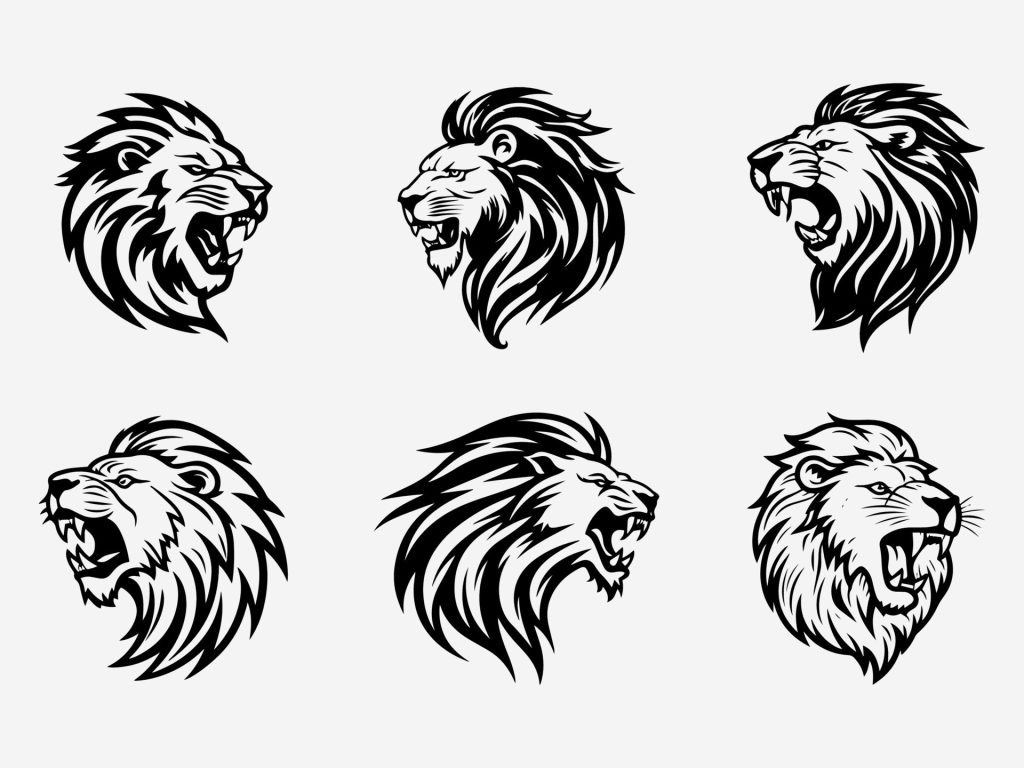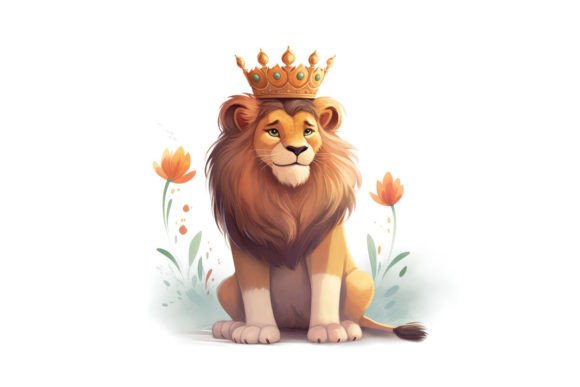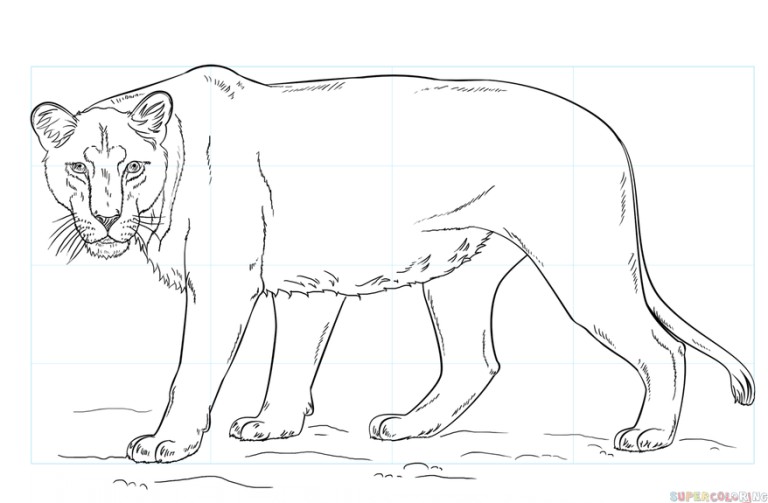Creating a lion drawing is a captivating journey that requires a delicate balance between grace and strength. The process begins with a meticulous study of the majestic creature, understanding its anatomy and distinctive features. The artist carefully outlines the powerful mane, capturing the untamed essence that defines the lion’s regal presence. Emphasis is placed on the eyes.

Exploring the Majesty of Lion Drawing
Embarking on a journey into the realm of lion drawing promises an encounter with majesty, power, and captivating beauty. These magnificent creatures ignite our imagination, demanding respect and captivating our gaze with their every stride. Whether you’re a seasoned artist or a curious beginner, exploring the art of lion drawing can be a rewarding and enriching experience.
1. Unveiling the Anatomy:
Understanding a lion’s anatomy is like deciphering the language of power. Their muscular build, powerful paws, and expressive eyes all contribute to their imposing presence. By studying skeletal references and photos, you’ll learn to capture the flow of their limbs, the weight distribution in their stance, and the subtle nuances of their facial expressions.
2. Mastering the Mane:
The lion’s mane is a crown of glory, symbolizing strength and maturity. Rendering its texture and flow can make or break your drawing. Explore different techniques like layering strokes, using stippling for density, and capturing the way light plays on the individual strands. Remember, the mane should enhance the lion’s presence, not overpower it.
3. Capturing the Gaze:
A lion’s eyes are windows to its soul, reflecting wisdom, curiosity, and perhaps a hint of danger. Mastering the portrayal of their eyes is crucial in conveying the essence of the beast. Pay attention to the shape, pupil size, and the subtle lines around the eyes that reveal emotions and tension. A well-drawn lion’s gaze can hold the viewer captive, creating a powerful connection.
4. Choosing Your Medium:
The possibilities for lion drawing are endless, each medium offering its own unique charm. Charcoal can create dramatic contrasts and expressive lines, while pastels can lend a touch of softness and subtle color variations. Pen and ink can capture the fluidity of movement, while digital painting allows for experimentation with light and textures. Choose a medium that resonates with your style and the mood you want to evoke.
5. Finding Inspiration:
Immerse yourself in the world of lions! Watch documentaries to observe their movements and expressions, study wildlife photography to capture their details, and explore the works of renowned animal artists like David Shepherd and Charles Frederick Tunnicliffe. Inspiration is everywhere, waiting to ignite your creativity.

The Art of Capturing Lion's Regal Crown
The lion’s mane, indeed, is a magnificent crown – a symbol of authority, power, and even vulnerability. Capturing its essence in your artwork requires careful observation and a strategic approach. Here are some tips to guide you:
Understanding the Mane:
- Anatomy: Start by familiarizing yourself with the skeletal structure underneath the mane. This helps you understand the flow and weight of the fur, its attachment points, and how it reacts to the lion’s movement.
- Types of mane: Explore the variations in mane styles depending on age, location, and even subspecies. A young male might have a wispy mane, while an older one boasts a full, impressive collar.
- Texture and Color: Study the texture of the fur – is it coarse or fine? Does it clump in tufts or flow smoothly? Pay attention to the color variations and subtle highlights within the mane.
Bringing the Mane to Life:
- Layering: Use layering techniques to build depth and texture. Start with light base strokes, then gradually add darker layers to define shadows and individual strands.
- Stippling: This technique, using tiny dots, can effectively create density and texture, especially for thick, matted manes.
- Highlighting: Strategic highlights on the tips of the fur strands and around the edges of the mane add realism and definition.
Tools and Techniques:
- Charcoal: Excellent for bold strokes and dramatic contrasts, ideal for capturing the wildness and power of the mane.
- Pastels: Offer softer blending and color variations, good for depicting a younger lion or a sun-drenched mane.
- Pen and Ink: Can create flowing lines and capture the movement of the fur, great for stylized or minimalist renditions.
- Digital Painting: Allows for experimentation with light, texture, and color, offering endless possibilities for creative expression.
Beyond Technique:
- Capture the Mood: Let the lion’s expression and posture guide your portrayal of the mane. A relaxed lion might have a flowing mane, while a tense one might have a bristled, upright mane.
- Symbolism: Remember, the mane holds symbolic weight. Use its texture and style to emphasize the lion’s dominance, age, or even vulnerability.
- Practice and Experiment: Don’t be afraid to try different techniques and approaches. The more you practice, the more you’ll develop your own unique style for capturing the majesty of the lion’s regal crown.

Expressive Detailing in Lion Drawings
Expressive detailing in lion drawings elevates them from mere images to captivating portrayals of these majestic creatures. It’s the magic touch that breathes life into fur, ignites emotion in their eyes, and whispers stories through their powerful paws. Here are some ways to infuse your lion drawings with expressive detail:
Eyes:
- Pupil size: Dilated pupils convey alertness and tension, while constricted ones suggest calmness or contentment.
- Iridescence: Capture the subtle gleam and color variations within the iris, adding depth and life to the gaze.
- Tears and wrinkles: A single tear rolling down a cheek can speak volumes of sorrow or loss, while subtle wrinkles near the eyes hint at age and wisdom.
Fur:
- Texture: Use different stroke lengths and directions to mimic the coarse, wiry texture of the mane or the softer, downy fur on the underbelly.
- Highlights and shadows: Play with light and shadow to create texture and volume in the fur. Accentuate individual strands with highlights and define depth with subtle shadows.
- Matting and tangles: Don’t shy away from depicting matted fur or playful tangles, adding a touch of realism and personality.
Muscles and Movement:
- Subtle twitches and flexes: Show subtle muscle movements beneath the skin, suggesting tension, anticipation, or the power held within.
- Footprints and claw marks: Leave traces of the lion’s presence in the environment, hinting at its journey or predatory nature.
- Pose and posture: Use the angle of the head, the curve of the spine, and the position of the limbs to tell a story. Is the lion poised for attack, relaxing in the sun, or surveying its territory?
Symbolism and Storytelling:
- Scars and weathered fur: These elements whisper tales of past battles, encounters, and the wisdom gained through experience.
- Raindrops clinging to fur: Capture the glistening beauty of raindrops, adding a touch of vulnerability and highlighting the contrast between the powerful beast and the delicate elements of nature.
- Entangled in thorns or vines: Use symbolism to portray challenges or hardships overcome, adding depth to the lion’s story.

Navigating the Creation of Lion Art
Whether you’re a seasoned artist or a curious beginner, navigating the creation of lion art can be an exhilarating adventure. It’s a journey filled with powerful emotions, artistic challenges, and the immense satisfaction of bringing these majestic creatures to life on canvas or paper. To guide you on this path, here are some helpful steps:
1. Finding Your Inspiration:
- Embrace the majesty: Immerse yourself in the world of lions! Watch documentaries to observe their movements and expressions, study wildlife photography to capture their details, and lose yourself in the works of renowned lion artists. Inspiration is everywhere, waiting to ignite your creativity.
- Define your message: Do you want to capture the raw power of a lion’s roar, the tenderness of a mother with her cubs, or the stoic wisdom of an elder? Defining your intention will guide your artistic choices and shape the emotions you evoke.
- Visualize your art: Start sketching rough compositions, explore different mediums and styles, and let your mind wander through the possibilities. The more you visualize your ideal artwork, the clearer your path will become.
2. Mastering the Anatomy:
- Knowledge is power: Understanding a lion’s skeletal structure, musculature, and fur distribution is crucial for creating realistic and expressive art. Reference photos, anatomical diagrams, and even visit zoos or wildlife sanctuaries if possible.
- Proportion is key: Pay close attention to the correct proportions of the head, body, limbs, and mane.
3. Capturing the Essence:
- The eyes are windows to the soul: Mastering the portrayal of a lion’s eyes is fundamental. Pay attention to pupil size, iridescence, and the subtle lines around the eyes that reveal emotions and tension. A well-drawn lion’s gaze can hold the viewer captive, creating a powerful connection.
- The language of fur: Explore different techniques to depict the texture and variations in the lion’s fur. Use layering, stippling, or highlights to create depth and realism, and remember that fur plays a crucial role in conveying emotions and movement.
- Don’t forget the details: Small details like scars, weathered fur, or raindrops clinging to the mane can add depth and storytelling to your art. Choose details that support your message and enhance the overall impact of your creation.
4. Choosing Your Tools and Techniques:
- Medium matters: Different mediums offer unique possibilities. Charcoal excels at bold strokes and dramatic contrasts, pastels lend a softer touch, pen and ink can capture movement, and digital painting allows for experimentation with light and texture. Choose a medium that resonates with your style and the mood you want to evoke.
- Embrace experimentation: Don’t be afraid to try different techniques and approaches. Practice drawing from different angles, explore lighting effects, and play with perspectives. The more you experiment, the more you’ll discover your own voice and unique style.
Choosing Colors for Vibrant Lion Art
To help you choose colors for your vibrant lion art, here are some specific things to consider:
1. Theme and mood:
- Fierce and powerful: Opt for warm, saturated colors like deep reds, oranges, and yellows for the mane, contrasting them with dark browns or blacks for the body.
- Playful and energetic: Explore brighter, cooler tones like turquoise, blues, and greens, especially for backgrounds or stylized lions.
- Majestic and serene: Use softer, analogous colors like honeyed browns, golden yellows, and earthy greens to create a harmonious and calming atmosphere.
2. Contrast and focal points:
- Use complementary colors: Pair contrasting colors like blue and orange, or green and red, to make your lion pop against the background and draw attention to specific areas.
- Highlighting and shadows: Emphasize key features like the eyes, nose, or paws with lighter or brighter colors. Use strategically placed shadows to create depth and dimension.
- Negative space: Don’t forget the power of negative space. Using areas of contrasting or complementary colors around the lion can help it stand out even more.
3. Inspiration and references:
- Look at wildlife photography: Observe how light and shadow play on lions in their natural habitat, focusing on the interplay of colors in their fur and surroundings.
- Study the masters: Research artists known for vibrant animal portraits, like Charley Harper or Robert Bateman, and see how they use color to create specific moods and effects.
- Create mood boards: Play with different color combinations and textures to visualize your chosen theme and see what resonates with you.
4. Tools and techniques:
- Experiment with different mediums: Acrylics and oil paints offer vibrant colors and bold strokes, while watercolors and colored pencils can create softer, nuanced effects.
- Layering and blending: Layer your colors to create depth and texture, and experiment with blending techniques to achieve smooth transitions or interesting visual effects.
- Glazing and scumbling: These techniques can add subtle color variations and enhance the realism of your lion’s fur.
A Step-by-Step Guide to Lion Drawing
Drawing a lion step by step can be an exciting and rewarding artistic journey. Follow these steps to create your own majestic lion illustration:
Step 1: Reference Gathering Begin by collecting reference images of lions. Study their anatomy, paying close attention to details like the mane, eyes, and body proportions.
Step 2: Sketch the Basic Shapes Start with simple shapes to outline the lion’s body. Use circles for the head, chest, and joints, and elongated ovals for the body and limbs. This basic framework will serve as your guide.
Step 3: Define the Body Structure Refine the shapes to outline the lion’s body more accurately. Add curves for the spine and muscles, ensuring a sense of strength and grace. Pay attention to the positioning of features like the shoulders and hips.
Step 4: Outline the Mane Emphasize the lion’s mane, framing its face. Lions have different mane styles, so choose one that suits your vision. Add flowing lines to depict the texture and volume of the mane.
Step 5: Detail the Face Focus on the facial features. Draw the eyes, nose, and mouth, capturing the intensity and expression of the lion. Don’t forget the ears, and use reference images to ensure accuracy.
Step 6: Refine the Mane and Fur Add more details to the mane, incorporating individual strands of hair to create a sense of realism. Extend the fur detailing to the lion’s body, paying attention to the direction of the fur growth.
Step 7: Strengthen Body Muscles Define the lion’s muscles and limbs with bold, confident lines. Consider the animal’s pose and ensure that the body proportions are accurate.
Exploring Different Styles in Lion Art
The world of lion art is bursting with diverse styles, each capturing the majesty and essence of these creatures in a unique way. Let’s embark on a journey of exploration through some captivating styles:
1. Realism:
- Meticulous detail: This style focuses on precise anatomical renderings, capturing every nuance of fur texture, muscle definition, and the soulful gaze of the lion’s eyes.
- Media: Charcoal, graphite pencils, and even oil paints excel at creating hyperrealistic effects.
- Artists: Charles Frederick Tunnicliffe, David Shepherd, and Rembrandt van Rijn are masters of this style.
2. Expressionism:
- Emotional intensity: This style emphasizes the lion’s raw power and emotions through exaggerated features, bold strokes, and dynamic compositions.
- Media: Acrylics, mixed media, and even sculptures can lend themselves to this dynamic style.
- Artists: Franz Marc, George Stubbs, and Elsa Gramcko are known for their expressive interpretations of lions.
3. Minimalism:
- Simplicity and elegance: This style strips away unnecessary details, focusing on clean lines, geometric shapes, and essential elements to convey the lion’s essence.
- Media: Ink drawings, digital art, and even origami can create striking minimalist representations.
- Artists: Alexander Calder, Charles M. Schulz, and Yuko Shimizu are some artists who explore minimalist animal art.
4. Pop Art:
- Bold colors and graphic elements: This style infuses the lion with vibrant hues, stylized features, and playful patterns, injecting a modern twist into the representation.
- Media: Acrylics, silkscreen prints, and even digital illustrations are perfect for achieving a pop art aesthetic.
- Artists: Andy Warhol, Roy Lichtenstein, and Jeff Koons have created iconic pop art representations of animals.
Frequently Asked Questions (FAQs)
Practice regularly, study anatomy, observe real-life subjects, and seek feedback from other artists. Online tutorials and classes can also be valuable.
Start with quality pencils, sketchbooks, erasers, and a sharpener. As you progress, you may explore different mediums like colored pencils, markers, or digital tools.
Experiment with different techniques, subjects, and mediums. Your style will emerge over time as you incorporate elements that resonate with you personally.
Related posts:
- Cute Girl Drawing : Tips for Creating Cute Girl
- Girl Drawing Easy : Benefits of Girl Drawing
- Landscape Drawing
- Oil Pastel Drawing : Mastering the Art of Oil Pastel
- Santa Claus Drawing : Tips for Drawing
- Save Water Drawing : How Art Inspires a Water-Wise Future
- Simple Drawings : Finding Beauty in Basic Lines
- Christmas Tree Drawing




















